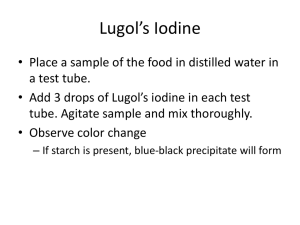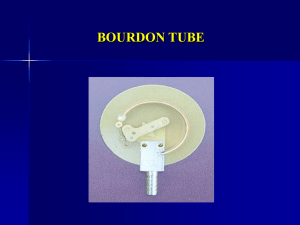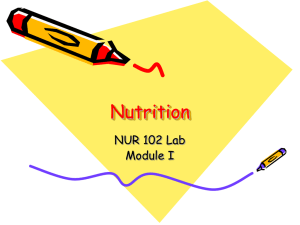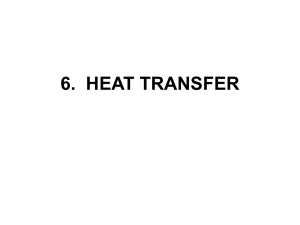ME 414 Design Project
advertisement
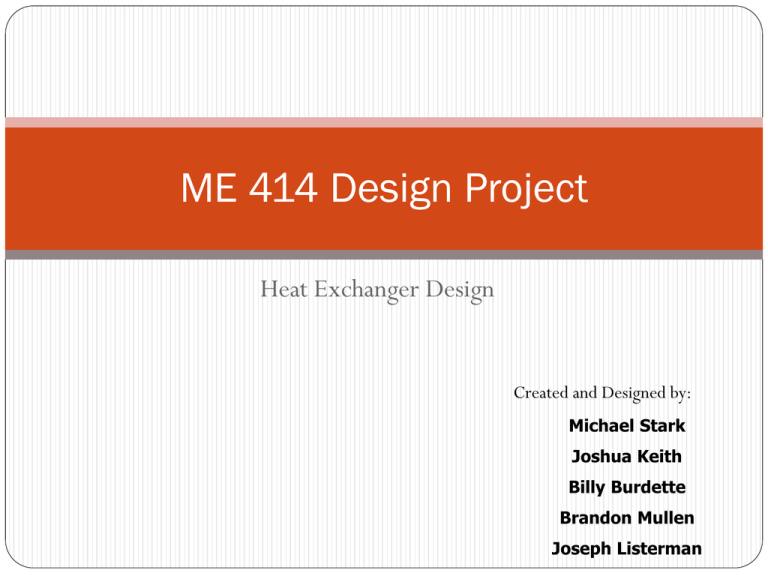
ME 414 Design Project Heat Exchanger Design Created and Designed by: Michael Stark Joshua Keith Billy Burdette Brandon Mullen Joseph Listerman Project Goals Design Heat Exchanger Create a light weight heat exchanger Heat exchange must be as efficient as possible Cost must be kept low as possible The size of the heat exchanger must be under design constraint Project Guidelines During the process of a liquid chemical product, its temperature needs to be reduced by 20 degrees Celsius. Mass flow rate is 220,000 kg/hr Fluid enters the heat exchanger at 45 C and should leave at 25 C Material properties of this chemical product can be approximated as water Cooling of the chemical product will be achieved by using treated city water City water is available at 20 C Mass flow rate is adjustable and one of the design parameters to be selected Exit temperature of city water from the heat exchanger is a function of the selected mass flow rate Professor Toksoy Project Optimization Must cool the chemical from 45 C to 25 C Heat exchanger length can not exceed 7 meters Heat exchanger shell diameter can not exceed 2 meters Minimize heat exchanger shell and tube weight hence the cost Minimize heat exchanger pressure drop Professor Toksoy Heat Exchanger Design Inputs for MATLAB • • • • • • • • • • • • • • Chemical to be cooled was set as Shell side liquid Mass flow rate of cooling water = 220 kg/sec Shell ID = .889 m Shell thickness = 5 mm Tube OD = 6.35 mm Tube thickness = .457 mm Tube Length = 2.88 m Baffle space = .6 m Helical Baffles Counter flow One shell pass and one tube pass Aluminum was used for both shell and tube materials Gnielinski equation used for tube side Nusselt correlation Square tube pitch Nusselt Correlation D.O.E. Run 1 Main Effects Plot for Weight Main Effects Plot for q_Calc Data Means Data Means mdot Shell mdot Shell Tube Length 1600000 1400000 4000 1200000 3000 2000 800000 200 240 2 4 Shell Mean 1000000 Mean Tube Length 5000 1000 200 240 2 4 Shell 1600000 5000 1400000 4000 1200000 3000 2000 1000000 1000 800000 0.5 0.5 1.5 Main Effects Plot for DP_Shell Main Effects Plot for DP_Tube Data Means Data Means mdot Shell 80000 1.5 mdot Shell Tube Length Tube Length 120000 60000 100000 40000 80000 200 240 Shell 80000 2 4 Mean Mean 20000 200 240 Shell 120000 60000 100000 40000 20000 80000 0.5 1.5 0.5 1.5 2 4 D.O.E. Run 2 Main Effects Plot for q_Calc Main Effects Plot for Weight Data Means 5600000 Tube Th Baffles Space 2500 5400000 2450 5200000 2400 5000000 2350 0.3 0.8 0.000457 0.000711 Baffle Cut 5600000 0.3 5400000 2450 5200000 2400 5000000 2350 0.8 0.000457 0.000711 Baffle Cut 2500 2300 4800000 0.1 0.5 0.1 0.5 Main Effects Plot for DP_Tube Main Effects Plot for DP_Shell Data Means Data Means Baffles Space 10000 Tube Th 8000 18000 6000 16000 4000 14000 2000 0.3 0.8 Baffle Cut 10000 0.000457 Baffles Space 20000 0.000711 Mean Mean Tube Th 2300 4800000 Mean Mean Data Means Baffles Space 12000 0.3 8000 18000 6000 16000 4000 14000 0.8 Baffle Cut 20000 2000 Tube Th 12000 0.1 0.5 0.1 0.5 0.000457 0.000711 Final D.O.E. Main Effects Plot for DP_Tube Main Effects Plot for q_Calc Data Means Data Means Tube Length Shell ID 7000000 9000 6000000 6000 5000000 3000 4000000 2 4 0.889 1.500 Tube OD 8000000 0 2 4 0.889 1.500 Tube OD 12000 7000000 9000 6000000 6000 5000000 3000 0 4000000 0.00635 0.00635 0.01270 0.01270 Main Effects Plot for Weight Main Effects Plot for DP_Shell Data Means Data Means Tube Length Tube Length Shell ID 2000 6000 1750 5000 1500 Shell ID 4000 1250 1000 3000 2 4 Tube OD 0.889 1.500 Mean Mean Shell ID 12000 Mean Mean 8000000 Tube Length 2 2000 6000 1750 5000 1500 4 Tube OD 4000 1250 3000 1000 0.00635 0.01270 0.00635 0.01270 0.889 1.500 Factorial Design Analysis – Heat Rate Pareto Chart of the Standardized Effects (response is q_Calc, Alpha = 0.05) 12.7 F actor A B C A Tube length has the largest Term C AC B AB BC 0 100 200 Standardized Effect 300 400 Normal Plot of the Standardized Effects (response is q_Calc, Alpha = 0.05) 99 Effect Ty pe Not Significant Significant 95 90 C 70 60 50 40 AC 30 AB 20 10 F actor A B C A 80 Percent affect on the heat rate. Shell ID has the smallest relative affect on heat rate. Shell ID had a negative affect on heat rate. This was a result of more tubes decreasing the velocity in the tube. The result is laminar flow inside the tube. N ame T ube Length S hell ID T ube O D B 5 1 0 100 200 Standardized Effect 300 400 N ame T ube Length S hell ID T ube O D Factorial Design Analysis - ∆P Tube We can see that tube length has the largest affect on tube side pressure drop. Shell ID has no affect on tube pressure drop. We expected tube OD to have a larger affect on tube side pressure drop. Pareto Chart of the Effects (response is DP_Tube, Alpha = 0.05) F actor A B C C Term A AC B BC AB 0 2000 4000 6000 8000 Effect 10000 12000 14000 N ame Tube Length S hell ID Tube O D Factorial Design Analysis - ∆P Shell Shell ID had the largest affect on shell side pressure drop. The affect of tube OD on the pressure drop was surprising. the 60° triangular pitch tube arrangement. As tube OD grows larger there is more pressure drop in the shell. (response is DP_Shell, Alpha = 0.05) 12.71 F actor A B C B C Term We attribute this affect to Pareto Chart of the Standardized Effects A BC AB AC 0 2 4 6 8 10 Standardized Effect 12 14 N ame Tube Length S hell ID Tube O D Factorial Design Analysis – HE Weight The shell inside diameter has the largest affect on weight. Pareto Chart of the Effects (response is Weight, Alpha = 0.05) The larger the shell Because tube length determines the length of the heat exchanger, it too has a large affect on heat exchanger weight. B A Term diameter the more tubes we could fit inside, thus increasing weight. F actor A B C AB C AC BC 0 1000 2000 Effect 3000 4000 N ame Tube Length S hell ID Tube O D Design Optimization - 1 The design optimized to our original design. We expected our final tube diameter to be 6.35 mm with a mass flow rate of 220 kg/s. Optimal Tube OD was 8.3mm The tube length was longer than our original design called for, which was a result of maximizing the q calculated. We set target values for the shell and tube side pressure drops. We set a target range for total weight between 900-1100 kg. Design Optimization - 2 New High D Cur 1.0000 Low Composite Desirability 1.0000 Tube Len 4.0 [2.6263] 2.0 Shell ID 1.50 [0.8890] 0.8890 Tube OD 0.0127 [0.0096] 0.0063 The design optimized to our original design. We expected our final tube diameter to be 6.35 mm with a mass flow rate of 220 kg/s. Optimal Tube OD was 8.3mm, adjusted it to 9.525 mm to coincide with standard tube dimensions. The tube length was longer than our original design called for, which was a result of maximizing the q calculated. We set target values for the shell and tube side pressure drops. We set a target range for total weight between 900-1100 kg. Weight Minimum y = 2288.8141 d = 1.0000 DP_Shell Minimum y = 1805.0741 d = 1.0000 DP_Tube Minimum y = 5865.8838 d = 1.0000 q_Calc Maximum y = 5.454E+06 d = 1.0000 Heat Exchanger Design Output from MATLAB Matlab Program Improvements Create program checks in order to eliminate unrealistic designs. If multiple tube passes are used with parallel flow it is possible to calculate a LMTD_CF that is an imaginary number. Provide the operator more detailed information regarding the Nusselt correlations. Cost Summary Heat Exchanger Dry Weight 730 Kg Heat Exchanger & Fluid Weight 2287 Kg Cost OnlineMetals.com $37.00 per 8ft length of aluminum tubing Total estimated aluminum tubing cost $337,000.00 $11.00 per 8ft length of mild steel tubing Total estimated mild steel tubing cost $100,000.00 Instillation and Manufacturing



